Infographic - 3 vs 4 Points On Chinese Pronunciation, The Easy And The Hard
08.10.2013 13:18:20
Have you thought of what makes Chinese pronunciation easy? Well, most learners of Chinese can easily see what makes it hard. Just identifying the easy and the hard parts of it, might actually give you that extra knowledge which it takes to master Mandarin pronunciation.
Pronunciation - The Easy Part
Let's start with the easy part. Even though these points may seem simple, many never thought about it.
Pronunciation Systematized in Pinyin
 Can you imagine if there was no pinyin or any other form of soundscript? You would have to memorize the pronunciation for each of the many thousands of words you'd have to learn. That is almost the way foreigners learn English. Even though there are some phonetic systems for English, only few use it thinking they can read the word directly anyway.
Can you imagine if there was no pinyin or any other form of soundscript? You would have to memorize the pronunciation for each of the many thousands of words you'd have to learn. That is almost the way foreigners learn English. Even though there are some phonetic systems for English, only few use it thinking they can read the word directly anyway.
We are very lucky the Mandarin Chinese pronunciation is not more complicated than that it can all be fitted into a phonetic system such as pinyin. Other wise it would hardly be learnable.
Just 30 Basic Sounds
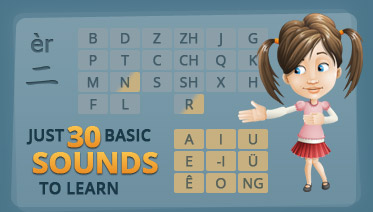 When you look at the the thousands of complicated Chinese characters or just the hundreds of possible pinyin syllables, you may be overwhelmed. But just think about this, if you master 30 basic sounds, then you have already learned every sound in Mandarin Chinese!
When you look at the the thousands of complicated Chinese characters or just the hundreds of possible pinyin syllables, you may be overwhelmed. But just think about this, if you master 30 basic sounds, then you have already learned every sound in Mandarin Chinese!
But it gets even better, please consider the next point.
Only 9 Tongue Positions
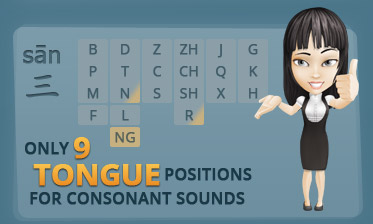 The 30 basic sounds are made up of 8 different vowel sounds, the remaining 22 consonant sounds can be produced with just 9 different tongue positions!
The 30 basic sounds are made up of 8 different vowel sounds, the remaining 22 consonant sounds can be produced with just 9 different tongue positions!
How is that possible? Are the 22 consonant sounds not different after all? Yes, they are different, but only to a certain extent. Take for example the letters Z, C and S. The only difference between these sounds is how big a puff you make, if any puff at all.
Please take a closer look at what Daidai is showing us in the infographic below. Look in the third illustration in the first column. There is a bunch of pinyin letters, and they are grouped according to tongue position. What do you think? Doesn't visualizing it this way make a seem a lot more do-able?
You may want to compare with the Anatomy section of the Standard Mandarin application.
Pronunciation - The Hard Part
All right, we are out of easy parts for the pronunciation, there is still 4 hard parts left. Identifying them may give you the upper hand in learning Chinese pronunciation. Let's get started.
Distinction Between Similar Sounds
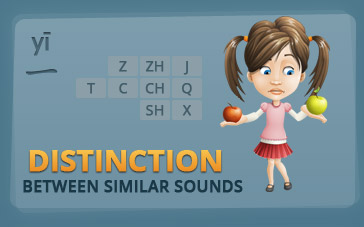 Yes, it can be quite hard to tell the difference between many of the Chinese sounds. That is also in part due to the fact, that they are basically the same. The only difference being, for example, how strong a puff you make, if any.
Yes, it can be quite hard to tell the difference between many of the Chinese sounds. That is also in part due to the fact, that they are basically the same. The only difference being, for example, how strong a puff you make, if any.
But even sounds that are not made with the same tongue position, can be hard to differentiate. For instance, many learners are tricked into thinking, that the letter 'T' is pronounced just like in English or some other western languages. The fact is, you will most likely need to learn the pronunciation of this all anew in order to differentiate it properly with the letter 'C'. And you must not fall into the other pit and pronounce 'T' like 'D'. That would be wrong as well.
Also, many find it particularly hard to hear the difference between ZH and J, CH and Q, SH and X.
How to deal with this effectively? Well, practice makes perfect.
4 Tones
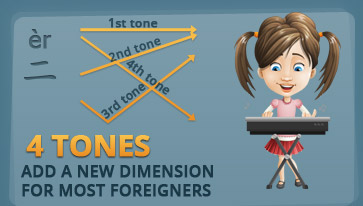 Granted, there are only so many different pronunciations in Chinese, but multiply that number with the 4 tones and it suddenly isn't that easy any more. On the other hand, when you master the 4 tones you can apply it on any syllable and thus the complexity is divided by 4 as well.
Granted, there are only so many different pronunciations in Chinese, but multiply that number with the 4 tones and it suddenly isn't that easy any more. On the other hand, when you master the 4 tones you can apply it on any syllable and thus the complexity is divided by 4 as well.
Tones as part of the language is a completely new thing to most western learners of Chinese. So it will take some time for most learners to get used to this.
Don't try and skip where the hedge is lowest, there is no way around it. The tones have to be learned.
3 Sounds of Tongue Splitting
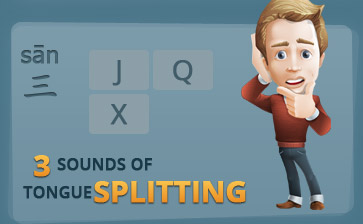 Don't worry, you don't need to actually split up your tongue. But to make the right sounds for J, Q and X you need to use your tongue in a completely new way. When you look at the Anatomy animation for these sounds, you may find that it looks almost like the tongue is splitting in two. Have fun!
Don't worry, you don't need to actually split up your tongue. But to make the right sounds for J, Q and X you need to use your tongue in a completely new way. When you look at the Anatomy animation for these sounds, you may find that it looks almost like the tongue is splitting in two. Have fun!
4 Sounds of Tongue Folding
These 4 sounds can be particularly hard to learn as well. These are often given most attention and are infamous for being very hard to learn. There are several reasons for that. One of them is simply that these sounds are hard to learn.
Another reason is that many Chinese people refer to these sounds as the 卷舌音 (Juǎn shé yīn). Which directly translated means "Roll Tongue Sound(s)". This name is probably the main reason why many Chinese natives actually think, you need to roll up your tongue and pull it far back towards your throat, in order to make these sounds properly.
Don't worry! That is not the way to make proper ZH, CH, SH and R sounds, also infamously known as 卷舌音 (Juǎn shé yīn).
Check out the Pronunciation Guide and Anatomy animations for these sounds in the Standard Mandarin software to learn it right. It really isn't that hard.
Another reason why these 4 sounds of tongue folding get so much attention, is the fact that people from southern China have a hard time pronouncing them. Some are even completely unable to do so, others are just too lazy to speak proper Mandarin.
Either way, even the 4 sounds of tongue folding are absolutely learnable for the foreign learner.

I hope you enjoyed this little walkthrough of the second section of the Infographic on Chinese Pronunciation and Pinyin. Check out the whole infographic here.
The section called "3 vs 4 - Pronunciation - The easy and the hard" is shown below.
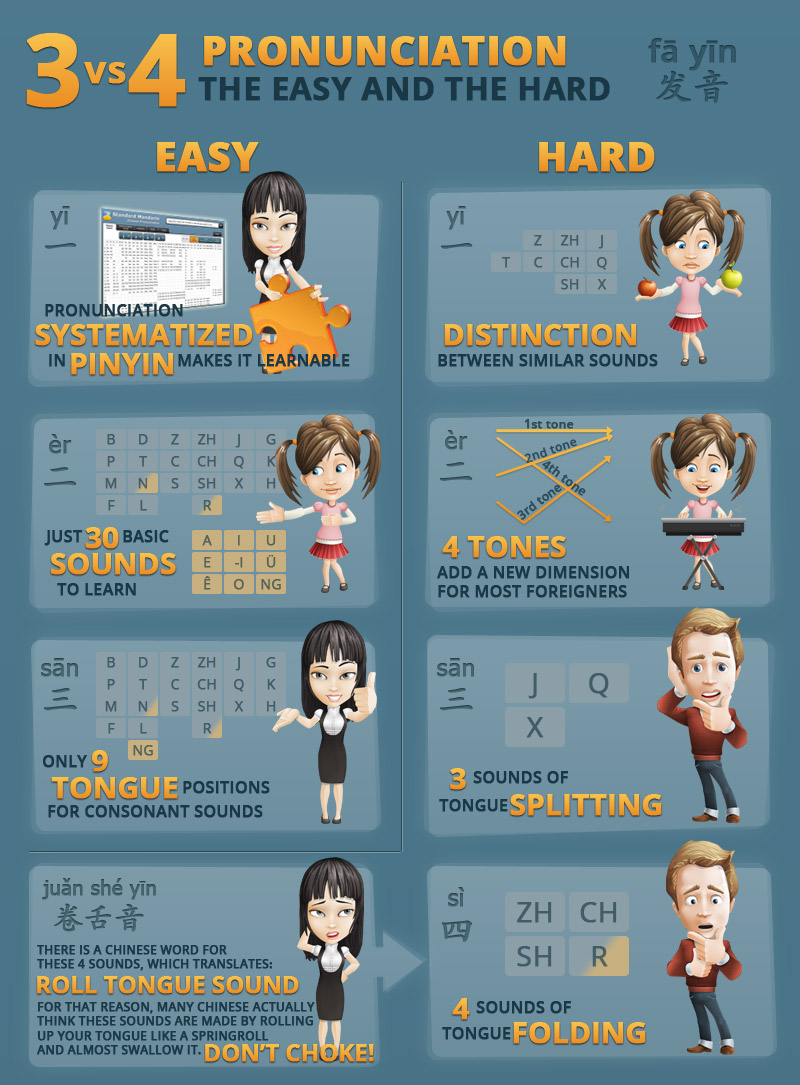

Did you like this page?